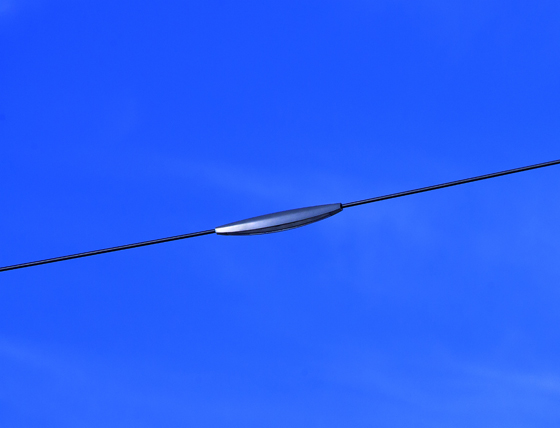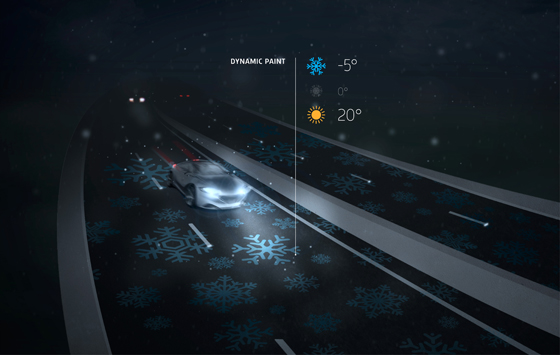Bright Lights, Big City: urban-lighting projects that dazzle
Text by Alyn Griffiths
London, United Kingdom
17.03.14
The highly utilitarian nature of urban lighting hasn’t stopped designers and manufacturers from adding value to projects that illuminate our cities through forward-facing design and technology. Architonic sheds some light…
....
....
Vogt + Partner used the METRO 100 suspended LED light from BURRI public elements to minimise disruptions at street level around Winterthur Bahnhofsvorplatz

Vogt + Partner used the METRO 100 suspended LED light from BURRI public elements to minimise disruptions at street level around Winterthur Bahnhofsvorplatz
×Cities are sites of 24-hour activity, and if you’ve ever been lost in one at night, taken an evening stroll, or tried to find a taxi after stumbling out of a nightclub, then you’ll appreciate the importance of safe and well-lit streets. Such practical concerns mean that urban lighting is often overlooked as a source of elegant and inspirational design. However, the need to develop products that can stand the test of time, both aesthetically and functionally, regularly results in pioneering innovations that are a match for the best contemporary architecture.
As well as ensuring that streets and public spaces are safe and attractive, one of the key concerns of city planners today is reducing energy consumption. For this reason, the evolution of energy-efficient lighting technologies such as LEDs has had a huge influence on the latest generation of street lights. The Rama LED from Spanish design brand Santa & Cole illustrates how the introduction of cutting-edge light sources enhances the performance of these products. Originally designed by Gonzalo Milá in 2000, the updated LED version of Rama provides a direct light that minimises light pollution and can be controlled accurately. Like other LED street lamps, it also has an impressive longevity of over 60,000 hours, meaning minimal maintenance is required.
The clean lines of Santa & Cole’s Rama LED street lights complement the surrounding contemporary architecture of the new Design HUB Barcelona. Individual refractor lenses direct light from a grid of LEDs downwards to reduce light pollution

The clean lines of Santa & Cole’s Rama LED street lights complement the surrounding contemporary architecture of the new Design HUB Barcelona. Individual refractor lenses direct light from a grid of LEDs downwards to reduce light pollution
×The amount of light emitted can be controlled to save energy when less light is required and the product requires minimal maintenance over its 60,000 hour lifespan

The amount of light emitted can be controlled to save energy when less light is required and the product requires minimal maintenance over its 60,000 hour lifespan
×Barcelona firm MBM Arquitectes used the Rama LED for the public spaces surrounding its recently completed design museum at the city’s new Design HUB. “We chose this light because of its simple design and regular form which shares some similarities with the museum building,” says Francesc Gual, who led the project for MBM Arquitectes. Gual adds that the choice of LED was informed by the city council’s mandate to upgrade all public lighting to LED in the coming years, and by the team’s ambition to create an urban landscape that is sustainable and low-maintenance.
While some LED lighting products such as the Rama LED have a slick, contemporary look that complements the efficient technology, the fact that these light sources are still viewed as an emerging technology gives designers carte blanche to interpret their use in many ways. As part of a new lighting scheme for the Hönggerberg campus at ETH Zürich university, lighting designer Reto Marty collaborated with Swiss manufacturer BURRI public elements to develop a new LED product resembling a traditional lamp shade fixed to a slender pole.
Lighting designer Reto Marty and BURRI public elements developed these LED lights that look like traditional lamp shades for ETH Zürich university. They introduce a domestic feel to the campus and create spaces for outdoor gatherings

Lighting designer Reto Marty and BURRI public elements developed these LED lights that look like traditional lamp shades for ETH Zürich university. They introduce a domestic feel to the campus and create spaces for outdoor gatherings
×The lamps are scattered around landscaped areas of the campus, giving these spaces a homely feel that encourages students to sit and relax outside. In line with the university’s goal of operating a sustainable campus, the use of LEDs has reduced energy consumption throughout the grounds by 75 percent, despite 40 additional lights being installed.
As well as efficiency, a key benefit of LED street-lighting solutions is their compact dimensions. As these products do not require a reflector and the bulbs themselves are smaller than their predecessors, the overall size can be reduced. This is accentuated when LEDs are used for suspended street lighting products such as the METRO 100 from BURRI, which has a slender profile that lends it a discreet presence when hung from a tensile cable.
As part of an upgrade of the lighting scheme around the Swiss city of Winterthur’s bus terminal, local lighting engineers Vogt & Partner specified the METRO 100, which was attached to an existing network of cables above the streets. The suspension system has the advantage of not adding to the clutter of the streetscape, with the light sources powered by the overhead cables. Vogt & Partner also wanted to ensure that diffused light did not reflect off the terminal’s sculptural metal canopy, and the precise downward light projected by the METRO 100’s LED matrix provided a practical solution.
BURRI public elements’ METRO 100 light provides focused downward illumination, featuring a compact LED matrix housed in a slender aluminium profile that draws heat away from the light source, helping it last longer

BURRI public elements’ METRO 100 light provides focused downward illumination, featuring a compact LED matrix housed in a slender aluminium profile that draws heat away from the light source, helping it last longer
×In the Swedish city of Malmö, an even more ethereal lighting system has been used to illuminate the busy Schougen’s Bridge. The bridge was previously lit by four mercury lamps that were inefficient and lacked the required brightness. The city’s public lighting department approached electronics giant Philips to develop a solution using its FreeStreet luminaire: a cable-mounted system of LED lamps with a minimal profile that appears to merge with the cable itself. New wires were suspended between four existing street-lighting poles in alignment with the bridge, resulting in a delicate web that is almost invisible during the day and at night illuminates the bridge accurately and efficiently.
Developing innovative and appropriate responses to specific urban-lighting scenarios requires close collaboration between city planners and lighting suppliers. When this collaboration goes wrong, the results can be costly, embarrassing and potentially dangerous. In 2005, Santa & Cole proposed a lighting scheme to Qatar’s public works authority Ashghal for a 10-kilometre stretch of a major thoroughfare in Doha. The company was subsequently surprised that the project was seemingly put on hold, and shocked when shoddily constructed copies of the Latina lights it had specified appeared along the road a few months later.
Schougen’s Bridge in Malmö is illuminated by FreeStreet LED luminaires from Philips, fixed to a minimal cable system. “We wanted it to be perceived as a starry sky or a ceiling of light,” says Malmö’s public-lighting manager, Johnny Clausen

Schougen’s Bridge in Malmö is illuminated by FreeStreet LED luminaires from Philips, fixed to a minimal cable system. “We wanted it to be perceived as a starry sky or a ceiling of light,” says Malmö’s public-lighting manager, Johnny Clausen
×Upon visiting the site, representatives from Santa & Cole were appalled by the build quality of the luminaires, which projected light into the eyes of drivers and employed dangerously substandard components. The company initiated legal proceedings against the State of Qatar in June 2012 for the moral and economic damage caused by the counterfeited products, and continues to fight for compensation despite the Qatari government refusing to recognise the case against it. “Unfortunately, we often face projects where our elements are copied," says Santa & Cole. "In most cases we are able to arrive at an understanding, and we also hope that in this long-lasting and sad case of Qatar our common western sense of justice will finally be served.” The case serves as a warning to designers and suppliers operating in an industry that is so reliant on direct cooperation with city planners.
Almost 1000 illegal copies of Santa & Cole’s Latina street light were installed along a stretch of Al Waab Street in Doha, Qatar

Almost 1000 illegal copies of Santa & Cole’s Latina street light were installed along a stretch of Al Waab Street in Doha, Qatar
×The original Latina street light was designed by architect Beth Galí in 1998 and is shown here in Saint Patrick Street in Cork, Ireland

The original Latina street light was designed by architect Beth Galí in 1998 and is shown here in Saint Patrick Street in Cork, Ireland
×Originality and innovation are key to generating urban lighting solutions that have long-lasting value, and some designers are looking beyond existing typologies to how new materials and technologies might shape the industry’s future. Dutch designer Daan Roosegaarde has been working on concepts for reactive road surfaces that could make streets more sustainable and intuitive. His proposals for a Smart Highway developed in collaboration with construction firm Heijmans Infrastructure include Dynamic Paint – a painted surface that reacts to changes in the ambient temperature by displaying relevant information such as diagrams of ice crystals to warn drivers of slippery conditions.
Another of Roosegaarde ideas, the Glow-in-the-dark Road, features road markings made from a photo-luminescent powder that stores energy from day light during the day and releases it as light at night, negating the need for additional lighting. “These are all ideas which are not super high-tech, they’re basic principles that we can implement on existing roads within the next three-to-five years,” claims Roosegaarde.
Top: Daan Roosegaarde’s Smart Highway concepts include a painted road surface that reacts to the temperature. Above: The Glow-in-the-Dark Road would reduce the need for additional street lighting

Top: Daan Roosegaarde’s Smart Highway concepts include a painted road surface that reacts to the temperature. Above: The Glow-in-the-Dark Road would reduce the need for additional street lighting
×Although it seems fantastical, Roosegaarde’s project is grounded in existing technologies and based on a real need to make infrastructure perform more effectively and efficiently. The projects represented in this article demonstrate how manufacturers of urban lighting are already exploiting innovative design and the latest technologies to develop attractive, intelligent, sustainable solutions, so why shouldn’t the next generation of products take this a step further? Look out for glow-in-the-dark paint coming to a street near you soon.
....


















